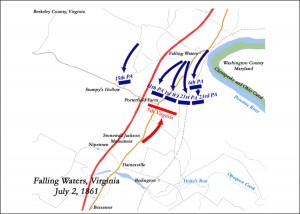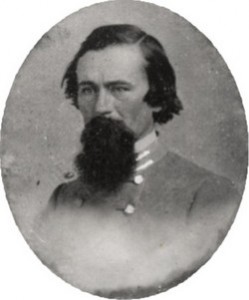James Johnston Pettigrew was born on 4 July 1828 at Bonarva, the Tyrrell County, North Carolina, plantation of his parents, Ebenezer and Ann Blount Shepard Pettigrew. Young Pettigrew was called Johnston by his friends and family. He was a phenomenally brilliant student and was an especially gifted mathematician. He entered the University of North Carolina at the age of fourteen, and graduated as the class valedictorian in 1847. After graduation, he spent six months as a professor at the Naval Observatory in Washington. From 1850 to 1852, Pettigrew studied law at the University of Berlin and traveled through much of Europe. He became fascinated with Spain and Italy, which he felt had much in common with the chivalric ideals, tradition, and hospitality of the American South.
Returning to America, Pettigrew joined the law firm of a cousin, James Louis Petigru of Charleston. (Petigru had reverted to the French spelling of the name.) Pettigrew flourished in Charleston, practicing law and serving in the legislature. He became convinced that a sectional war was coming, and dedicated himself to serving in the South Carolina militia and teaching himself about military science. In 1859 he returned to Europe to join the war for Italian independence, hoping to help this cause and to gain military experience. The war ended as he arrived, but he spent some time visiting military camps and studying with some French officers. After leaving Italy Pettigrew went to Spain and gathered materials for a book, [amazon_link id=”1570039046″ target=”_blank” locale=”US” container=”” container_class=”” ]Notes on Spain and the Spaniards in the Summer of 1859, with a glance at Sardinia[/amazon_link], which he published in 1861. Pettigrew spoke several languages, including Hebrew and Arabic. He intended to write a history of the Moors in Spain, but the Civil War ended his plans for that work.
Pettigrew was so well regarded as an authority on military matters that when South Carolina left the Union in December 1860, he was appointed as chief military aide to Governor Francis W. Pickens and became colonel of the 1st South Carolina Rifles. On 27 December, after the Federal garrison at Charleston slipped away to Fort Sumter, Pettigrew was sent with a protest from the governor. Later that day Pettigrew led a small detachment that occupied Castle Pinckney. From January 1861 until the firing on Fort Sumter, he was in charge of various South Carolina army camps around Charleston Harbor.
 After Fort Sumter, Pettigrew wanted a post that would allow him to lead men in combat; he avoided service on military boards or staffs. Finding nothing to his liking, he went to Virginia as a private in Hampton’s Legion. While there, on 11 July 1861, he learned that he had been elected, nearly unanimously, as colonel of the 22nd North Carolina. During the winter of 1861-1862, his regiment took part in the Confederate blockade of the Potomac. Pettigrew refused promotion to brigadier general several times, feeling that he should not accept such rank without having led troops in battle. He finally consented in March 1862.
After Fort Sumter, Pettigrew wanted a post that would allow him to lead men in combat; he avoided service on military boards or staffs. Finding nothing to his liking, he went to Virginia as a private in Hampton’s Legion. While there, on 11 July 1861, he learned that he had been elected, nearly unanimously, as colonel of the 22nd North Carolina. During the winter of 1861-1862, his regiment took part in the Confederate blockade of the Potomac. Pettigrew refused promotion to brigadier general several times, feeling that he should not accept such rank without having led troops in battle. He finally consented in March 1862.
Pettigrew’s Brigade, which included his 22nd North Carolina, and units from Georgia, Virginia, Arkansas, and Maryland, fought at Seven Pines on 31 May 1862. Pettigrew was shot through the throat while observing the enemy lines. He thought the wound was fatal and refused to be moved to the rear. Pettigrew was left behind and reported dead on the field when his men withdrew. He was shot again and bayoneted before he as taken prisoner the next day.
Pettigrew was exchanged in August 1862 and given a new brigade, made up of the 11th, 26th, 44th, 47th and 52nd North Carolina Regiments. His brigade was sent to southeastern Virginia and eastern North Carolina from September 18621 to May 1863, where it took part in several small battles around Washington and New Bern.
In May 1863 Pettigrew’s brigade was sent to the Army of Northern Virginia and assigned to Henry Heth’s Division. At Gettysburg on 1 July, Pettigrew’s brigade drove enemy troops, including the famous Iron Brigade, from McPherson’s Ridge. Pettigrew took command of the division when Heth was wounded. The brigade lost heavily in officers and men on 1 July. The 26th North Carolina’s losses reached 72 percent, the highest loss in a single day of any regiment in the war, according to authority William F. Fox.
On 2 July Pettigrew and Heth’s division were granted some rest, but they were called to action again on 3 July. Lee planned a frontal assault on the center of the Union lines on Cemetery Ridge, which has become known as Pickett’s Charge. The fresh division of Major General George Pickett made up the right of the assaulting force. Heth’s Division, led by Pettigrew, was on the left, with two brigades of Pender’s Division behind them. They were unable to break the lines on Cemetery Ridge and withdrew with terrible losses. Pettigrew was wounded in the hand, and led his men on foot after his horse was shot.
 In the retreat from Gettysburg, Pettigrew was shot in the stomach on 14 July in a rear guard action near the Potomac at Falling Waters, Maryland. Although told it would be fatal to move him, Pettigrew refused to remain and be captured again. He insisted on going with the army, and was taken to Bunker Hill, in present-day West Virginia, where he died on 17 July.
In the retreat from Gettysburg, Pettigrew was shot in the stomach on 14 July in a rear guard action near the Potomac at Falling Waters, Maryland. Although told it would be fatal to move him, Pettigrew refused to remain and be captured again. He insisted on going with the army, and was taken to Bunker Hill, in present-day West Virginia, where he died on 17 July.
Pettigrew was buried in Raleigh, but his body was moved to the family graveyard at Bonarva after the war. The fallen general was mourned and honored by his native state. his name was memorialized in Pettigrew Hospital, established in Raleigh in 1864, and the 1912 Battle-Vance-Pettigrew Building at the University of North Carolina. In 1939 much of the land of Bonarva Plantation was incorporated into Pettigrew State Park, North Carolina’s sixth state park.
- David A. Norris
[Source: Heidler, David S. and Jeanne T. Heidler. Encyclopedia of the American Civil War: A Political, Social and Military History. W.W. Norton & Co. 2002. pp. 1506-1507]



Pingback: On this date in Civil War history: Battle of Falling Waters - July 14, 1863 | This Week in the Civil War